|
HOME
ABOUT APNSS
NEWS
SEARCH
MEMBERSHIP
Becoming a member
Officers and Directors
NEW
PLATE NUMBERS
PUBLICATIONS
Plate Numbers
Articles
Hebert's Catalog
Classified ads
CIRCUITS
VIEW EXAMPLES
LINKS
American Philatelic Society
United States Stamp Society
Linn's Stamp News
Scott Publishing
...More
|
|
1929 Kansas-Nebraska issues
Due to a rash of post office robberies in the Midwest, the 1¢-10¢
values of the then-current definitive series were overprinted with "Kans."
or "Nebr." in an effort to prevent their use in other states and diminish
their resale potential. The plan was not successful and was not
continued for other states or other stamp issues.
Kansas issues
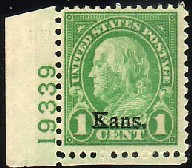 Scott
658, 1¢,
plate number 19339 Scott
658, 1¢,
plate number 19339
 Scott
658 var, 1¢ with overprint high and to the right, plate number 19339 Scott
658 var, 1¢ with overprint high and to the right, plate number 19339
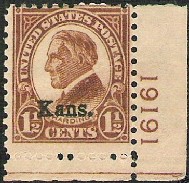 Scott
659, 1-1/2¢, plate number
19191 Scott
659, 1-1/2¢, plate number
19191
 Scott
660 var, 2¢,
plate number 19273, high overprint Scott
660 var, 2¢,
plate number 19273, high overprint
 Scott
661, 3¢,
plate number 18126 Scott
661, 3¢,
plate number 18126
 Scott
661 var, 3¢ with overprint overinked, with additional ink splotches, plate number 18803 Scott
661 var, 3¢ with overprint overinked, with additional ink splotches, plate number 18803
 Scott
661 var, 3¢, no period after "Kans", plate number 18803 Scott
661 var, 3¢, no period after "Kans", plate number 18803
 Scott
662, 4¢,
plate number 18082 Scott
662, 4¢,
plate number 18082
 Scott
662 var, 4¢ with low overprint, plate number 18038 Scott
662 var, 4¢ with low overprint, plate number 18038
 Scott
663, 5¢,
plate number 18907 Scott
663, 5¢,
plate number 18907
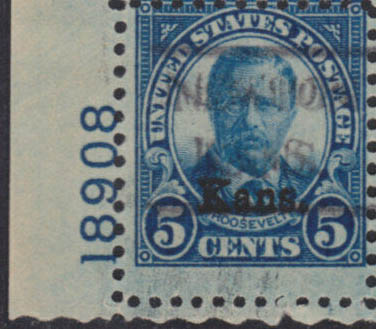 Scott
663 var, 5¢ precanceled, plate number 18908 Scott
663 var, 5¢ precanceled, plate number 18908
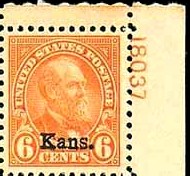 Scott
664, 6¢,
plate number 18037 Scott
664, 6¢,
plate number 18037
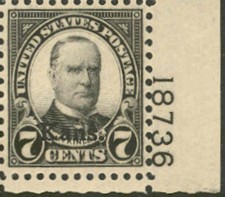 Scott
665, 7¢, plate
number 18736 Scott
665, 7¢, plate
number 18736
 Scott
666, 8¢, plate number
18192 Scott
666, 8¢, plate number
18192
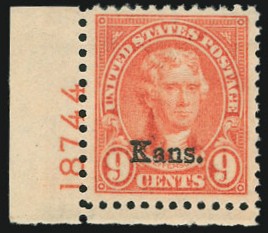 Scott
667, 9¢, plate
number 18744 Scott
667, 9¢, plate
number 18744
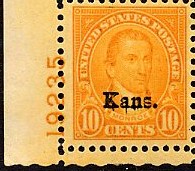 Scott
668, 10¢, plate number
19235 Scott
668, 10¢, plate number
19235
Nebraska issues
 Scott
669, 1¢,
plate number 19338 Scott
669, 1¢,
plate number 19338
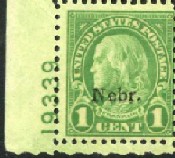 Scott
669 var, 1¢,
plate number 19339,
high overprint Scott
669 var, 1¢,
plate number 19339,
high overprint
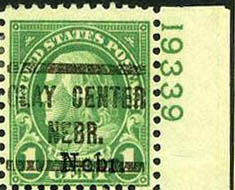 Scott
669 var, 1¢ precanceled, plate number 19339 Scott
669 var, 1¢ precanceled, plate number 19339
 Scott
670 var, 1-1/2¢,
plate number 19182,
high overprint Scott
670 var, 1-1/2¢,
plate number 19182,
high overprint
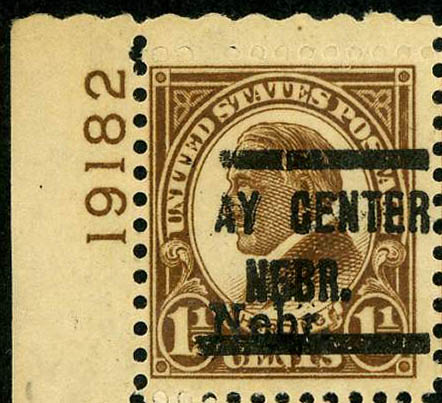 Scott
670 var, 1-1/2¢ precanceled, plate number 19182,
broken precanel mat missing CL of CLAY CENTER Scott
670 var, 1-1/2¢ precanceled, plate number 19182,
broken precanel mat missing CL of CLAY CENTER
 Scott
671, 2¢,
plate number 19059 Scott
671, 2¢,
plate number 19059
 Scott
671 var, 2¢,
plate number 19431,
high overprint Scott
671 var, 2¢,
plate number 19431,
high overprint
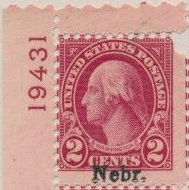 Scott
671 var, 2¢, plate number 19431,
low overprint Scott
671 var, 2¢, plate number 19431,
low overprint
 Scott
671 var, 2¢ with inverted precancel, plate number 19431 Scott
671 var, 2¢ with inverted precancel, plate number 19431
 Scott
672, 3¢,
plate number 18803 Scott
672, 3¢,
plate number 18803
 Scott
672 var, 3¢, plate number 18804, extremely high overprint Scott
672 var, 3¢, plate number 18804, extremely high overprint
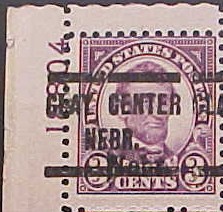 Scott
672 var, 3¢ precanceled,
plate number 18804 Scott
672 var, 3¢ precanceled,
plate number 18804
By the time the 1-1/2¢ overprint illustrated above was done, the precancel mat had become worn or torn and the CL of CLAY CENTER did not print.
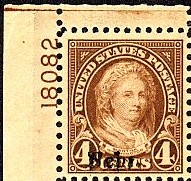 Scott
673, 4¢,
plate number 18082 Scott
673, 4¢,
plate number 18082
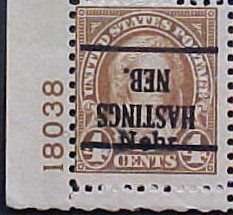 Scott
673 var, 4¢ with inverted precancel,
plate number 18038 Scott
673 var, 4¢ with inverted precancel,
plate number 18038
 Scott
674, 5¢,
plate number 18908 Scott
674, 5¢,
plate number 18908
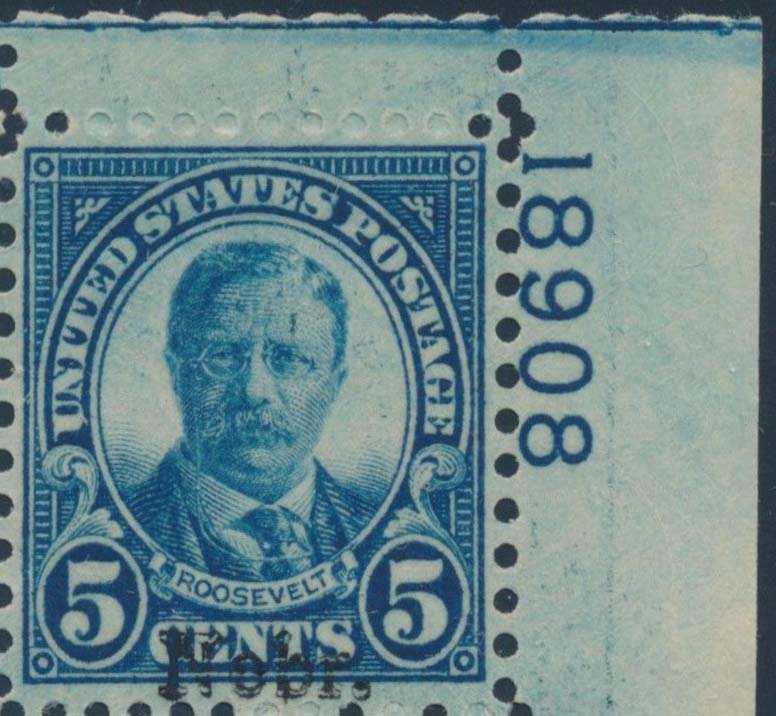 Scott
674 var, 5¢, low overprint, plate number 18908 Scott
674 var, 5¢, low overprint, plate number 18908
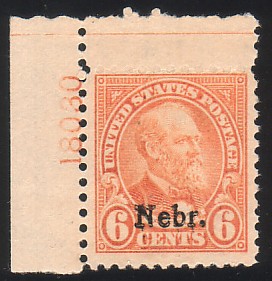 Scott
675, 6¢,
plate number 18030 Scott
675, 6¢,
plate number 18030
 Scott
675 var, 6¢ precanceled,
plate number 18037 Scott
675 var, 6¢ precanceled,
plate number 18037
 Scott
676, 7¢,
plate number 18736 Scott
676, 7¢,
plate number 18736
 Scott
676 var, 7¢, high overprint, plate number 18740 Scott
676 var, 7¢, high overprint, plate number 18740
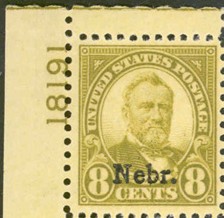 Scott
677, 8¢, plate number 18191 Scott
677, 8¢, plate number 18191
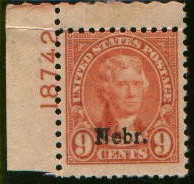 Scott
678, 9¢,
plate number 18742 Scott
678, 9¢,
plate number 18742
 Scott
678 var, 9¢ precanceled,
with very high
overprint, plate number 18744 Scott
678 var, 9¢ precanceled,
with very high
overprint, plate number 18744
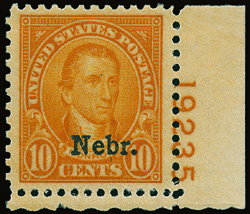 Scott
679, 10¢ yellow, plate number 19235 Scott
679, 10¢ yellow, plate number 19235
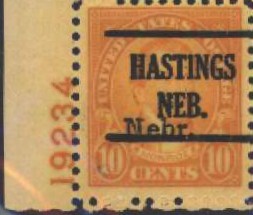 Scott
679 var, 10¢ orange, precanceled, plate number 19234 Scott
679 var, 10¢ orange, precanceled, plate number 19234
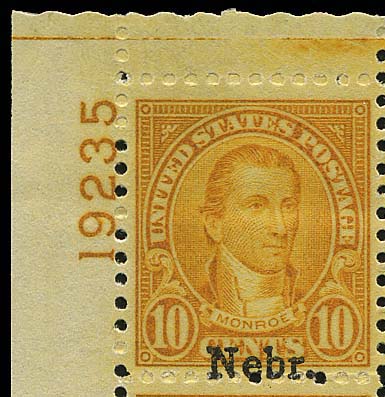 Scott
679 var, 10¢, plate number 19235, low overprint Scott
679 var, 10¢, plate number 19235, low overprint
Rogues' Gallery: Examples of fake Kansas-Nebraska
plate number singles
Example #1: Scott
637, 5¢ Roosevelt with fake Nebr.
overprint
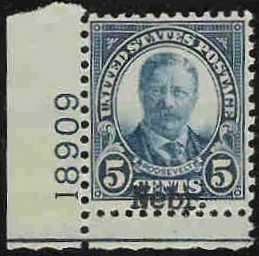
Clues:
- Only plates 18907 and 18908 were used
on genuine 5¢ Nebraska overprints; 18909 is not known
- The font (type face) does not match
known genuine issues, as seen most clearly in the lower case "e" and "r"
- The period is raised too high from
the base line of the type, indicating that it was probably typed with a
manual typewriter. Also, the overprint is placed unusually low,
but this in itself is not unknown on genuine issues.
Image from a 2004 eBay lot offered as a genuine Scott 674.
Example #2: Scott
637, 5¢ Roosevelt with fake Nebr.
overprint
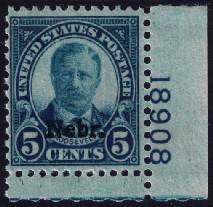
 Enlargement of faked 'Nebr.' Enlargement of faked 'Nebr.'
 Enlargement of genuine 'Nebr.' Enlargement of genuine 'Nebr.'
Clues:
- This time, a correct plate number was
selected from among the several used to print Scott 637.
- However, while the type font is
closer to the genuine one than that of the Fake 5¢ Nebraska Example #1,
the ascender of the 'b' is not tall enough and its bowl (the O part) is
too narrow, and the arm of the 'r' is too long. Compare with the
'Nebr.' in genuine examples above, most easily seen on the 6¢, 9¢ and
10¢ stamps, and in the enlargement from a genuine 6¢ example.
- The period on genuine overprinted
stamps occupies its own space, and is very slightly raised above the
base line of the type. On the faked example, the period is too far
to the left, appearing actually under the arm of the 'r'. It also
appears to be on the exact same level as the letters.
Image from a 2007 eBay lot offered as a genuine Scott 674.
Example #3: Scott
641, 9¢ Jefferson with fake Nebr.
overprint

Clues:
- Only plates 18742 and 18744 were used
on genuine 9¢ Nebraska overprints; 19355 was never overprinted.
- The font is a better match than that
used on the 5¢ Example #1, but still has problems with the "N" (too
narrow), "e" (horizontal bar too high) and "r" (right extender too
long); and the period is too full.
- The overprint looks "typed,"
over-inked -- the real thing looks "printed" and has "holes" in the
inked overprint letters.
- Also, while we have seen overprints
that are placed high or low, or a bit to the right or left, genuine
overprints are not known other than dead-on level -- this one slopes up
to the right.
- The real key is the plate number --
in this case, the faker might have been better off offering it as a
normal single stamp.
Image from a 2003 eBay lot clearly described as a faked Scott 678.
Example #4: genuine Scott
663, 5¢ Roosevelt, but with blue color chemically altered
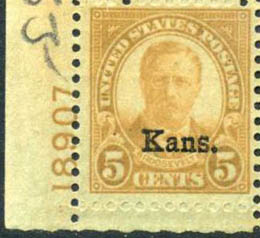
Clues:
- The normal 5¢ blue Scott 637 is not known with a color error.
- There is no way that the personnel responsible for overprinting the already-printed 5¢ stamps would have allowed a full pane of misprinted stamps to continue the overprinting process. The pane would have been immediately destroyed.
- It is relatively easy to alter blue ink chemically or by exposure to light.
- The stamp itself may not have been altered at all. The stamp color might have been altered using any number of graphical software applications.
Example #5: genuine Scott
635, 3¢ Lincoln with fake Nebr. overprint
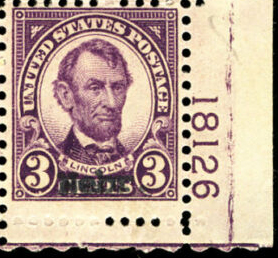
Clues:
- The font, spacing and clarity of the "Nebr." overprint are all wrong.
- The overprint looks "typed,"
over-inked (perhaps typed twice?) -- the real thing looks "printed" and has "holes" in the
inked overprint letters.
- When viewed in the context of the plate block of four from which this PNS was photographically cropped, the Nebr. overprints are not on the same level from one stamp to the next. Since the mat used to apply the overprints is in fact perfectly level, having stamps in the same row with overprints appearing at different levels is simply not possible. The fake overprints were clearly typed onto each stamp.
- When viewed in the context of the plate block of four, the Nebr. overprints are not evenly aligned for stamps in the same column. Again, the overprint mat is perfect, with level Nebr. in horizontal rows, and aligned Nebr. in vertical columns. For an entire pane of 100, the overprints might be high or low, or slightly left or right, but it is not possible for adjacent stamps to be misaligned individually.
- In other examples from this plate block where the Nebr. appears over a whiter background, it is clear that the overprint is the grayish-black of typewriter ribbon ink, rather than the true black of the printer's ink used for genuine overprints.
Image from a 2019 eBay lot listed twice, at different prices, as a genuine Scott 672 plate block.
Example #6: genuine Scott
634, 2¢ Washington with fake Kans. overprint
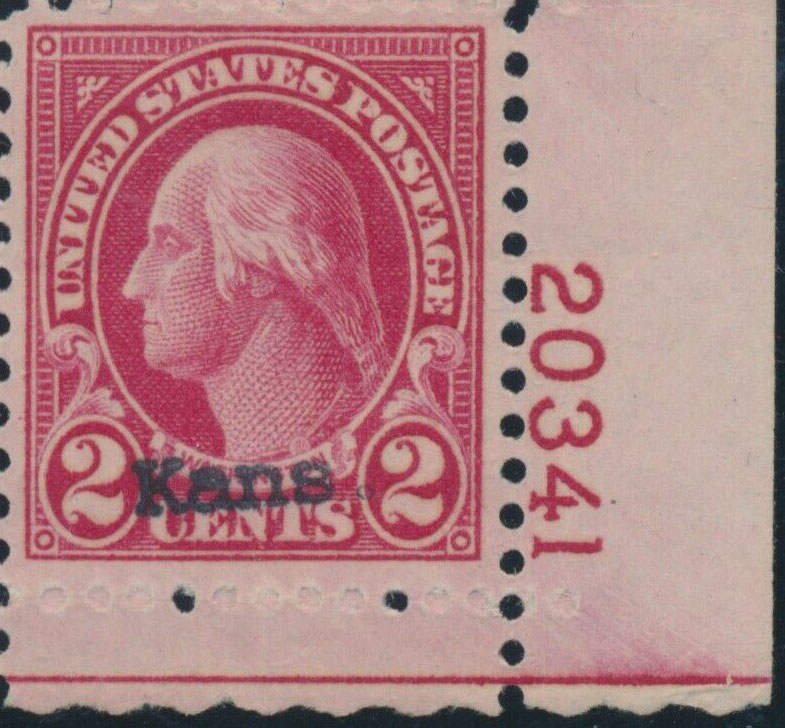
Clues:
- Plate number 20341 was not among the 12 plates used on overprints of the 2¢ denomination.
- The font and spacing of the "Kans." overprint are wrong. All four letters are too short and too wide, and the period is too far away.
- The overprint is not level. The overprint was made done using a mat that was clamped to the press, making skewed overprints impossible.
- When viewed in the context of the plate block of four from which this image was photographically cropped, the Kans. overprints are not evenly aligned for stamps in the same column. Again, the overprint mat is perfect, with level Kans. in horizontal rows, and aligned Kans. in vertical columns. For an entire pane of 100, the overprints might be high or low, or slightly left or right, but it is not possible for adjacent stamps to be misaligned individually.
Image from a 2020 eBay lot offered as a genuine Scott 660 plate block described as having a "diagonal overprint shift error."
Comments? Suggestions? Email the
Webmaster: 
This page last updated August 12, 2020. 
|
 Scott
658, 1¢,
plate number 19339
Scott
658, 1¢,
plate number 19339 Scott
658 var, 1¢ with overprint high and to the right, plate number 19339
Scott
658 var, 1¢ with overprint high and to the right, plate number 19339 Scott
659, 1-1/2¢, plate number
19191
Scott
659, 1-1/2¢, plate number
19191 Scott
660 var, 2¢,
plate number 19273, high overprint
Scott
660 var, 2¢,
plate number 19273, high overprint Scott
661, 3¢,
plate number 18126
Scott
661, 3¢,
plate number 18126 Scott
661 var, 3¢ with overprint overinked, with additional ink splotches, plate number 18803
Scott
661 var, 3¢ with overprint overinked, with additional ink splotches, plate number 18803 Scott
661 var, 3¢, no period after "Kans", plate number 18803
Scott
661 var, 3¢, no period after "Kans", plate number 18803 Scott
662, 4¢,
plate number 18082
Scott
662, 4¢,
plate number 18082 Scott
662 var, 4¢ with low overprint, plate number 18038
Scott
662 var, 4¢ with low overprint, plate number 18038 Scott
663, 5¢,
plate number 18907
Scott
663, 5¢,
plate number 18907 Scott
663 var, 5¢ precanceled, plate number 18908
Scott
663 var, 5¢ precanceled, plate number 18908 Scott
664, 6¢,
plate number 18037
Scott
664, 6¢,
plate number 18037 Scott
665, 7¢, plate
number 18736
Scott
665, 7¢, plate
number 18736 Scott
666, 8¢, plate number
18192
Scott
666, 8¢, plate number
18192 Scott
667, 9¢, plate
number 18744
Scott
667, 9¢, plate
number 18744 Scott
668, 10¢, plate number
19235
Scott
668, 10¢, plate number
19235 Scott
669, 1¢,
plate number 19338
Scott
669, 1¢,
plate number 19338 Scott
669 var, 1¢,
plate number 19339,
high overprint
Scott
669 var, 1¢,
plate number 19339,
high overprint Scott
670 var, 1-1/2¢,
plate number 19182,
high overprint
Scott
670 var, 1-1/2¢,
plate number 19182,
high overprint Scott
670 var, 1-1/2¢ precanceled, plate number 19182,
broken precanel mat missing CL of CLAY CENTER
Scott
670 var, 1-1/2¢ precanceled, plate number 19182,
broken precanel mat missing CL of CLAY CENTER Scott
671, 2¢,
plate number 19059
Scott
671, 2¢,
plate number 19059 Scott
671 var, 2¢,
plate number 19431,
high overprint
Scott
671 var, 2¢,
plate number 19431,
high overprint Scott
671 var, 2¢, plate number 19431,
low overprint
Scott
671 var, 2¢, plate number 19431,
low overprint Scott
672, 3¢,
plate number 18803
Scott
672, 3¢,
plate number 18803 Scott
672 var, 3¢, plate number 18804, extremely high overprint
Scott
672 var, 3¢, plate number 18804, extremely high overprint Scott
672 var, 3¢ precanceled,
plate number 18804
Scott
672 var, 3¢ precanceled,
plate number 18804 Scott
673, 4¢,
plate number 18082
Scott
673, 4¢,
plate number 18082 Scott
673 var, 4¢ with inverted precancel,
plate number 18038
Scott
673 var, 4¢ with inverted precancel,
plate number 18038 Scott
674, 5¢,
plate number 18908
Scott
674, 5¢,
plate number 18908 Scott
674 var, 5¢, low overprint, plate number 18908
Scott
674 var, 5¢, low overprint, plate number 18908 Scott
675, 6¢,
plate number 18030
Scott
675, 6¢,
plate number 18030 Scott
675 var, 6¢ precanceled,
plate number 18037
Scott
675 var, 6¢ precanceled,
plate number 18037 Scott
676, 7¢,
plate number 18736
Scott
676, 7¢,
plate number 18736 Scott
676 var, 7¢, high overprint, plate number 18740
Scott
676 var, 7¢, high overprint, plate number 18740 Scott
677, 8¢, plate number 18191
Scott
677, 8¢, plate number 18191 Scott
678, 9¢,
plate number 18742
Scott
678, 9¢,
plate number 18742 Scott
678 var, 9¢ precanceled,
with very high
overprint, plate number 18744
Scott
678 var, 9¢ precanceled,
with very high
overprint, plate number 18744 Scott
679, 10¢ yellow, plate number 19235
Scott
679, 10¢ yellow, plate number 19235 Scott
679 var, 10¢ orange, precanceled, plate number 19234
Scott
679 var, 10¢ orange, precanceled, plate number 19234 Scott
679 var, 10¢, plate number 19235, low overprint
Scott
679 var, 10¢, plate number 19235, low overprint

 Enlargement of faked 'Nebr.'
Enlargement of faked 'Nebr.'



